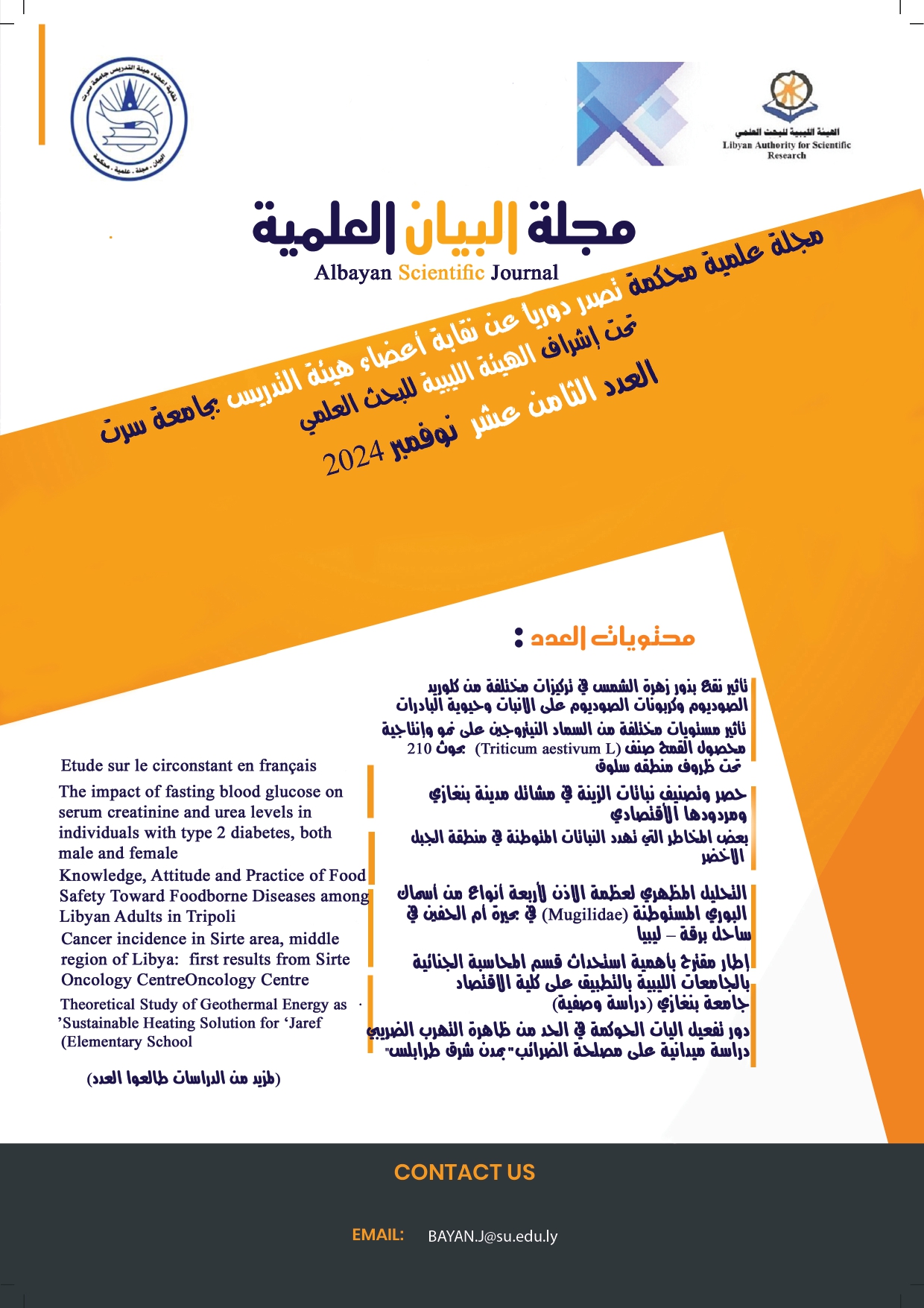تأثير جلوكوز الدم الصائم على مستويات الكرياتينين واليوريا في بلازما الدم لدى الأفراد المصابين بداء السكري من النوع الثاني ذكوراً وإناثاً
DOI:
https://doi.org/10.37375/bsj.vi18.3027الكلمات المفتاحية:
مرض السكري من النوع 2، اليوريا، الكرياتينينالملخص
يؤثر مرض السكري في مراحله المتقدمة على وظائف الكبد، بما في ذلك تركيز اليوريا والكرياتينين في دم المرضى. أجريت هذه الدراسة البحثية في قسم السكري بمستشفى الثورة الواقع شمال مدينة البيضاء. شارك فيها مائة شخص وتم تقسيمهم إلى مجموعتين. المجموعة الأولى، والمعروفة باسم المجموعة الضابطة، تكونت من 50 شخصاً (30 رجلاً و20 امرأة). أما المجموعة الثانية، والتي يشار إليها بمجموعة المرضى، فقد تألفت من 50 شخصاً (28 رجلاً و22 امرأة). تم أخذ عينات الدم من هؤلاء الأفراد، وتم تحديد تركيز السكر واليوريا والكرياتينين في دمهم الصائم باستخدام الطرق القياسية. وتم إجراء تحليل إحصائي على نتائج هذه الاختبارات. كان متوسط عمر الأشخاص في المجموعة الضابطة 48 ± 9.0، في حين كان متوسط عمر مرضى السكري 53 ± 9.3 سنة. كان متوسط تركيز السكر في الدم لدى المرضى الذكور أقل بشكل ملحوظ مقارنة بالمرضى الإناث. بالإضافة إلى ذلك، كان تركيز الكرياتينين واليوريا في الدم لدى المرضى الإناث أقل بشكل ملحوظ مقارنة بالمرضى الذكور. وهذا يشير إلى أن تأثير مرض السكري من النوع 2 على وظائف الكلى يختلف بين الذكور والإناث. كانت مستويات الجلوكوز واليوريا والكرياتينين في الدم لدى مرضى السكري من النوع 2 متفاوتة في كل من الذكور والإناث.
المراجع
Anjaneyulu, M. & Chopra, K. (2004). Quercetin, an anti‐oxidant bioflavonoid, attenuates diabetic nephropathy in rats. Clinical and Experimental pharmacology and physiology, 31, 244-248.
Bamanikar, S., Bamanikar, A. A. & Arora, A. (2016). Study of Serum urea and Creatinine in Diabetic and nondiabetic patients in a tertiary teaching hospital. The Journal of Medical Research, 2, 12-15.
Chutani, A. & Pande, S. (2017). Correlation of serum creatinine and urea with glycemic index and duration of diabetes in Type 1 and Type 2 diabetes mellitus: A comparative study. National journal of physiology, pharmacy and pharmacology, 7, 914-914.
Deshmukh, C. D., Jain, A. & Nahata, B. (2015). Diabetes mellitus: a review. Intrnational. Journal of Pure Applied. Bioscience, 3, 224-230.
Ezema, G. O., Omeh, N. Y., Egbachukwu, S., Agbo, E. C., Ikeyi, A. P., & Obeagu, E. I. (2023). Evaluation of biochemical parameters of patients with type 2 diabetes mellitus based on age and gender in Umuahia. Asian Journal of Dental and Health Sciences, 3(2), 32-36.
Hofsø, D., Jenssen, T., Bollerslev, J., Røislien, J., Hager, H. & Hjelmesæth, J. (2009). Anthropometric characteristics and type 2 diabetes in extremely obese Caucasian subjects: a cross-sectional study. Diabetes Research and Clinical Practice, 86, e9-e11.
Jasem, N. M. & Abdul-Razaq, A. S. (2023). Evalution of Biomarkers in Iraq Patients with Diabetes Mellitus Type 2. The Egyptian Journal of Hospital Medicine, 90, 3062-3066.
Khuwaja, A., Rafique, G., White, F. & Azam, S. (2004). Macrovascular complications and their associated factors among persons with type 2 diabetes in Karachi, Pakistan--a multi-center study. Journal of Pakistan Medical Association, 54, 60.
Li, R., He, M., Yang, Q., Liang, Z., Li, Y., Huang, L., Wu, R., & Huang, J. (2023). Association between serum creatinine and type 2 diabetes in the Chinese population: a retrospective cohort study. Scientific Reports, 13(1), 6806.
Mishra, K., Mawar, A., Kare, P. K. & Verma, N. (2015). Relationship between fasting blood glucose, serum urea, serum creatinine and duration of diabetes in Type-2 diabetic patients. Flora Fauna, 21, 127-32.
Neugarten, J., Acharya, A. & Silbiger, S. R. (2000). Effect of gender on the progression of nondiabetic renal disease: a meta-analysis. Journal of the American Society of Nephrology, 11, 319-329.
Ninomiya, T., Perkovic, V., De Galan, B. E., Zoungas, S., Pillai, A., Jardine, M., Patel, A., Cass, A., Neal, B. & Poulter, N. (2009). Albuminuria and kidney function independently predict cardiovascular and renal outcomes in diabetes. Journal of the American Society of Nephrology, 20, 1813-1821.
Remuzzi, G., Schieppati, A. & Ruggenenti, P. (2002). Nephropathy in patients with type 2 diabetes. New England Journal of Medicine, 346, 1145-1151.
Richard, E. J., Augustine, A. O., Ani, C. O., Chime, P. U., Jide, U. U., Francis, A. U., Pamela, O. O., Chinemerem, N. C., Onyemaechi, A. B. & Paul, E. C. (2017). Serum urea, uric acid and creatinine levels in diabetic mellitus patients attending Jos University Teaching Hospital, North central Nigeria. International Journal of Biosciences, 11, 68-72.
Romagnani, P., Remuzzi, G., Glassock, R., Levin, A., Jager, K. J., Tonelli, M., Massy, Z., Wanner, C. & Anders, H.-J. (2017). Chronic kidney disease. Nature reviews Disease primers, 3, 1-24.
Rossing, K., Christensen, P. K., Hovind, P., Tarnow, L., Rossing, P. & Parving, H.-H. (2004). Progression of nephropathy in type 2 diabetic patients. Kidney international, 66, 1596-1605.
Schutte, J. E., Longhurst, J. C., Gaffney, F. A., Bastian, B. C. & Blomqvist, C. G. (1981). Total plasma creatinine: an accurate measure of total striated muscle mass. Journal of Applied Physiology, 51, 762-766.
Schwartz, G. J., Brion, L. P. & Spitzer, A. (1987). The use of plasma creatinine concentration for estimating glomerular filtration rate in infants, children, and adolescents. Pediatric clinics of North America, 34, 571-590.
Shera, A. S., Jawad, F., Maqsood, A., Jamal, S., Azfar, M., Ahmed, U. & Anurekha, J. (2004). Prevalence of chronic complications and associated factors in type 2 diabetes. PMA-Journal of Pakistan Medical Association. , 54, 54-59.
Triplitt, C. L. (2012). Understanding the kidneys' role in blood glucose regulation. American Journal of Managed Care, 18, S11.
Wagle, T. J. (2010). Genderwise comparison of serum creatinine and blood sugar levels in type-2 diabetic patients. Bombay Hosptail Journal, 52, 64-8.
Whaley-Connell, A., Sowers, J. R., Mccullough, P. A., Roberts, T., Mcfarlane, S. I., Chen, S.-C., Li, S., Wang, C., Collins, A. J. & Bakris, G. L. 2009. Diabetes mellitus and CKD awareness: the kidney early evaluation program (KEEP) and national health and nutrition examination survey (NHANES). American Journal of Kidney Diseases, 53, S11-S21.
Yin, X., Wang, Y., Jiang, J., Zhong, F., & Zhang, Q. (2024). Association of blood urea nitrogen to creatinine ratio with incident type 2 diabetes mellitus: A retrospective cohort study in the Chinese population. Medicine, 103(30), e39003.














